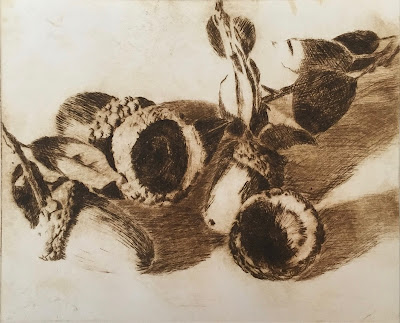I haven't posted in quite a while. The projects that I've been working on are large and have consumed more time than I had anticipated. I have 2 paintings, each 2x4 feet, that I have been working on for months and months, and I've been working on a 5 plate etching series that has taken the same length of time. I'm nearing completion on both projects, and look forward to soon sharing them here in my step by step way.
But I must confess, my life hasn't all been work. My 3 big art projects have been interrupted countless times in the last 6 months by marvelous trips. We've been called to northern Europe, San Diego and Paso Robles for the weddings of family and friends and we've joined friends in Mexico and Hawaii. My heart is full, my head is swimming with new images but I find that it's hard to remain productive while living like the rich and famous!
In response to feeling a bit bogged down I popped off an experiment that I was interested in trying. In the past I spent years on a series of 3 color stacked mono prints, winding up focusing on head studies. I was interested in seeing what a 3 color drypoint, creating color and value using line rather than tone, might look like.
I didn't belabor the development of the image or the drawings. I acted on impulse, and am quite pleased with the results!
 |
This is the first plate, where I'm establishing warm yellow tones, and anywhere I want green or orange.
|
 |
| This is my second plate. Here I'm drawing line where I want pure red, orange or purple. |
 |
| Here is a print of those two plates, the red printed over the yellow. I like what I see, but am surprised to see that I'm not getting many secondary color mixes. |
 |
| Here is my third plate, establishing the deepest darks on the face and hair and creating the environment. |
 |
And here are all 3 plates printed on top of one another! I like the result and it's raw feeling. Playing with a new technique was really fun and a perfect antidote for my long and labored projects.
|

















































